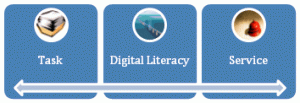We would like to say a huge thank you to all the researchers who gave up their time to take part in yesterday’s workshop exploring digital literacy. We are using the valuable information gathered to establish a baseline of attitudes and practicesamongst researchers todigital technology. Representatives ranged from postgraduate students through to early stage researchers, mid-career and senior research staff. This varied group provided us with a broad range of views and illuminating discussion on the value and application of technology for research work. Unsurprisingly, there was an extremely diverse range of practices described, with some researchers making extensive use of a wide variety of digital technologies whilst others preferred a traditional approach, working with pen, paper and post-its to meet their particular needs.
Concern was expressed that an overly strong emphasis on technology driven (rather than task driven) methods may promote ways of working that aren’t necessarily the most effective or productive. Researchers are acutely conscious of the time and effort required not only to find out about what technologies are available but also change the way they work. A clear message was that researchers need to be provided appropriate and timely information to help them make a considered choice about the relative value of comparative technology for changing their practice; it must be fit for purpose and demonstrably add value. This highlights a significant challenge for the university to identify ways of raising awareness and understanding of technology enabled opportunities amongst researchers and how to target and tailor education and support. Further information and analysis of this workshop along with findings from an online survey will be available early April as the project’s second baseline report.

